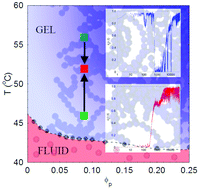Relaxation in aging thermoreversible gels: the role of thermal history†
Abstract
The fast setting of gels originating from an arrested phase separation leads to solid structures that incorporate a substantial amount of frozen-in stresses. Using a colloidal system made of particles whose interactions can accurately be tuned with temperature and exploiting Photon Correlation Imaging (PCI), an optical correlation technique blending the powers of scattering and imaging, we show that the relaxation of these internal stresses, which occurs through a cascade of microscopic restructuring events, is strongly influenced by the thermal history of the sample. By changing with a temperature jump the interparticle interactions in an already set gel, we specifically show that gels formed by a deep quench within the coexistence region store a lot of residual stress. This stress quickly relaxes when the interparticle attractions are weakened by decreasing temperature. Conversely, the relaxation of stresses accumulated in gels obtained by a shallower quench comes to a halt by a temperature jump that hardens the gel structure. The evidence we collected may provide useful hints about tempering and annealing processes in disordered solids.



 Please wait while we load your content...
Please wait while we load your content...